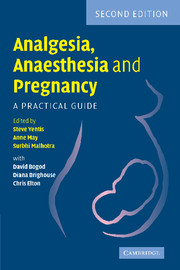Book contents
- Frontmatter
- Contents
- List of contributors
- Preface
- SECTION 1 PRECONCEPTION AND CONCEPTION
- SECTION 2 PREGNANCY
- I Procedures in early/mid-pregnancy
- II Normal pregnancy and delivery
- III Operative delivery and third stage
- IV Anaesthetic complications
- V Problems confined to obstetrics
- VI Problems not confined to obstetrics
- VII The neonate
- SECTION 3 PUERPERIUM AND AFTER
- SECTION 4 ORGANISATIONAL ASPECTS
- Index
SECTION 4 - ORGANISATIONAL ASPECTS
Published online by Cambridge University Press: 10 November 2010
- Frontmatter
- Contents
- List of contributors
- Preface
- SECTION 1 PRECONCEPTION AND CONCEPTION
- SECTION 2 PREGNANCY
- I Procedures in early/mid-pregnancy
- II Normal pregnancy and delivery
- III Operative delivery and third stage
- IV Anaesthetic complications
- V Problems confined to obstetrics
- VI Problems not confined to obstetrics
- VII The neonate
- SECTION 3 PUERPERIUM AND AFTER
- SECTION 4 ORGANISATIONAL ASPECTS
- Index
Summary
ANTENATAL EDUCATION
Women preparing for childbirth make use of many sources of information. These will typically include discussion with other women, magazine articles, books and classes. Classes may be run by the GP practice or maternity unit, or by external bodies such as the National Childbirth Trust (NCT). Antenatal education is beneficial, since it has been shown that the well-informed mother will cope better with labour, but it is important that the information received by the mother should be accurate, well balanced and relevant to local conditions (there is, after all, little point in discussing the virtues of epidural analgesia if no such service is available in the local hospital).
Much of the information given to mothers in the antenatal period is outside the control of the anaesthetist and may well be inaccurate or misleading; it is therefore particularly important for the anaesthetist to seek every opportunity to get his/her message across.
Problems/special considerations
Retention of information
The middle of a painful labour is the wrong time to attempt to provide quite complex information about regional analgesia. In addition to the pain itself and the inevitable tension, the mother may well be under the influence of powerful sedative/analgesic drugs. Theoretically, the antenatal period is the ideal time to educate mothers about pain relief and anaesthesia for Caesarean section. Unfortunately, many studies have shown that the ability of patients to recall details of explanations is poor and that such information tends to be retained for the short term only.
- Type
- Chapter
- Information
- Analgesia, Anaesthesia and PregnancyA Practical Guide, pp. 345 - 374Publisher: Cambridge University PressPrint publication year: 2007



